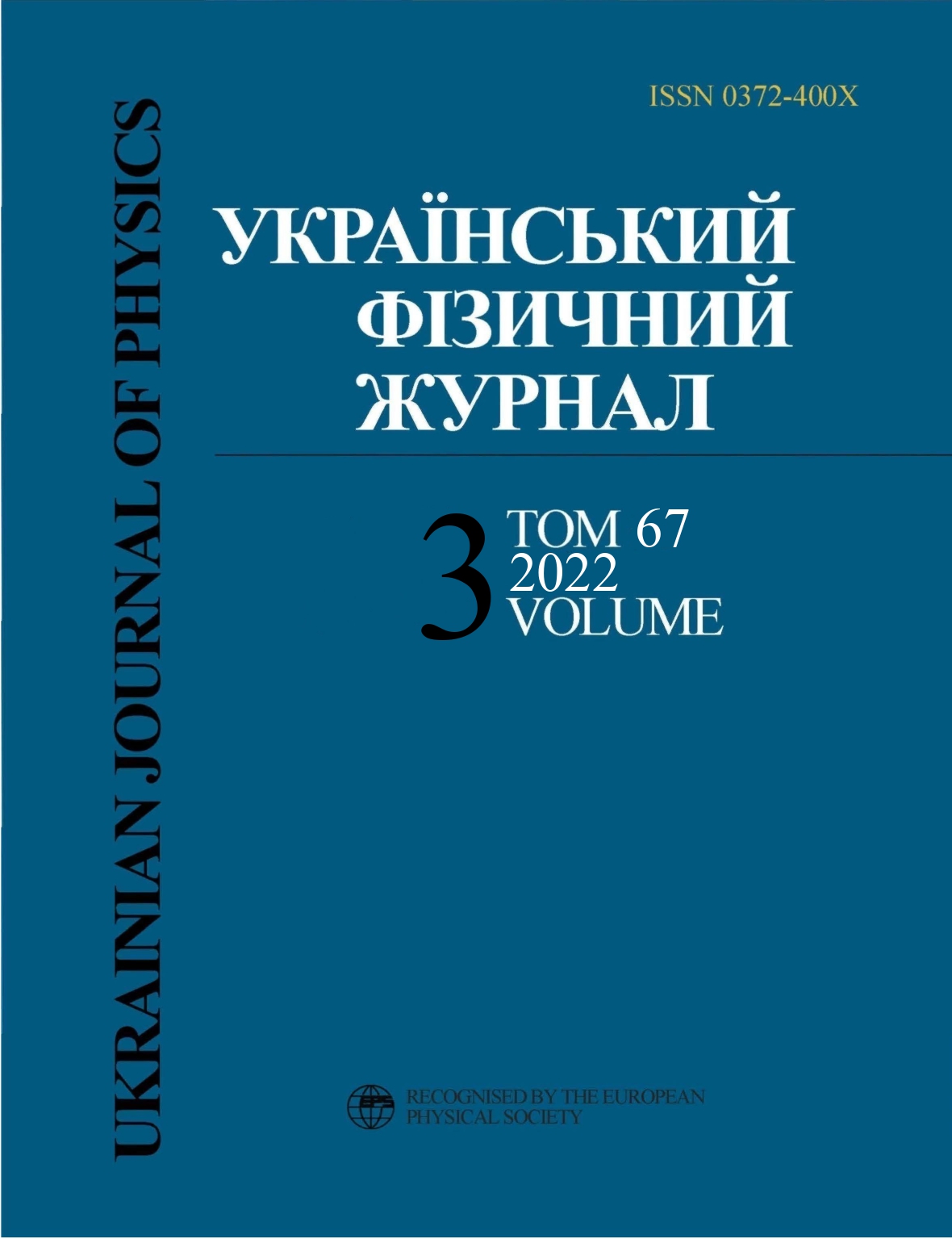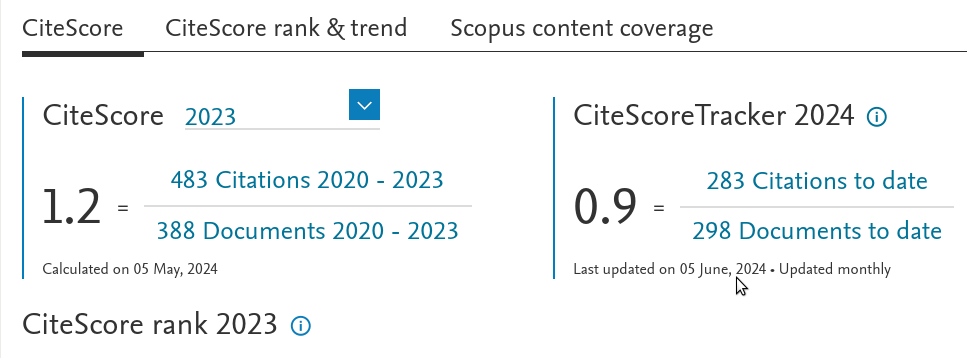Напівпровідникові оксиди металів, леговані наночастинками золота, для використання в газових сенсорах ацетону
DOI:
https://doi.org/10.15407/ujpe67.3.216Ключові слова:
SnO2, наночастинки золота, сенсори ацетонуАнотація
Дослiджено вплив нанорозмiрних частинок золота на адсорбцiйно-чутливi властивостi сенсорiв на основi SnO2–Au при детектуваннi парiв ацетону. Були використанi рiзнi методи приготування нанокомпозитiв SnO2–Au iз середнiм розмiром частинок Au 2 нм. Встановлено, що п’ятикратне збiльшення вiдгуку сенсора на пари ацетону та порогова чутливiсть (Clim) 0,1 ppm досягаються при додаваннi золота до дiоксиду олова в колоїднiй формi в процесi синтезу. Додавання золота в iоннiй формi (Au(III)) приводить до збiльшення вiдгуку сенсора на пари ацетону в 2,7 рази i визначає Clim 0,2 ppm. Нахил градуювальних кривих сенсорiв SnO2–Au дозволяє реєструвати пари ацетону в дiапазонi концентрацiй вiд Clim до 5 ppm. Цей дiапазон концентрацiй можна використовувати для експрес-дiагностики цукрового дiабету. Пiдвищену чутливiсть SnO2–Au-сенсорiв до парiв ацетону можна пояснити пiдвищенням адсорбцiйно-каталiтичної активностi iонiв олова в результатi модифiкуючої дiї сульфатних груп та залучення високодисперсного золота до адсорбцiйно-каталiтичного процесу окислення молекул ацетону.
Посилання
D. Hill, R. Binions. Breath analysis for medical Diagnosis. Inter. J. on Smart Sensing and Intelligent Systems 5, 401 (2012).
https://doi.org/10.21307/ijssis-2017-488
B. Buszewski, M. Kesy, T. Ligor, A. Amann. Human exhaled air analytics: Biomarkers of diseases. Biomed. Chromatogr. 21, 553 (2007).
https://doi.org/10.1002/bmc.835
V. Saasa, T. Malwela, M. Beukes, M. Mokgotho, Ch-Pu Liu, B. Mwakikunga. Sensing technologies for detection of acetone in human breath for diabetes diagnosis and monitoring. Diagnostics 8, 12 (2018).
https://doi.org/10.3390/diagnostics8010012
M. Righettoni, A. Tricoli. Toward portable breath acetone analysis for diabetes detection. J. Breath. Res. 5, 037109 (2011).
https://doi.org/10.1088/1752-7155/5/3/037109
M. Masikini, M. Chowdhury, O. Nemraoui. Review-metal oxides: Application in exhaled breath acetone chemiresistive sensors. J. Electrochem. Soc. 167, 037537 (2020).
https://doi.org/10.1149/1945-7111/ab64bc
N. Alizadeh, H. Jamalabadi, F. Tavoli. Breath acetone sensors as non-invasive health monitoring systems: A review. IEEE Sensors Journal 20, 5 (2020).
https://doi.org/10.1109/JSEN.2019.2942693
S. Americo, E. Pargoletti, R. Soave, F. Cargnoni, M.I. Trioni, G.L. Chiarello, G. Cerrato, G. Cappelletti. Unveiling the acetone sensing mechanism by WO3 chemiresistors through a joint theory-experiment approach. Electrochimica Acta 371, 137611 (2020).
https://doi.org/10.1016/j.electacta.2020.137611
J. Hu, C. Zou, Y. Su, M. Li, Z. Yang, M. Ge, Y. Zhang. One-step synthesis of 2D C3N4-tin oxide gas sensors for enhanced acetone vapor detection. Sens. Actuators B Chem. 253 641 (2017).
https://doi.org/10.1016/j.snb.2017.06.176
X. Guan, Y. Wang, P. Luo, Y. Yu, D. Chen, X. Li. Incorporating N atoms into SnO2 nanostructure as an approach to enhance gas sensing property for acetone. Nanomaterials 9, 445 (2019).
https://doi.org/10.3390/nano9030445
E. Ovodok, M. Ivanovskaya, D. Kotsikau, V. Kormosh, I. Alyakshev. Kotsikau, V. Kormosh, I. Alyakshev. The structure and the gas sensing properties of nanocrystalline tin dioxide synthesized from tin(II) sulphate physics. Chem. Appl. Nanostr. 313 (2015).
https://doi.org/10.1142/9789814696524_0078
E. Ovodok, M. Ivanovskaya, D. Kotsikau, V. Kormosh, P. Pylyp, V. Bilanych. Structural characterization and gas sensing properties of nano-sized tin dioxide material synthesized from tin(II) sulfate. Ukr. J. Phys. 66, 803 (2021).
https://doi.org/10.15407/ujpe66.9.803
M. Ivanovskaya, E. Ovodok, T. Gaevskaya, D. Kotsikau, V. Kormosh, V. Bilanych, M. Micusik. Effect of Au nanoparticles on the gas sensitivity of nanosized SnO2. Mater. Chem. Phys. 258, 123858 (2021).
https://doi.org/10.1016/j.matchemphys.2020.123858
L.M. Kustov, V.B. Kazansky, F. Figueras, D. Tichit. Investigation of the acidic properties of ZrO2 modified by SO−42 anions. J. Catal. 150, 143 (1994).
https://doi.org/10.1006/jcat.1994.1330
C. Guhrenz, A. Wolf, M. Adam, L. Sonntag, S.V. Voitekhovich, S. Kaskel, N. Gaponik, A. Eychm¨uller. Tetrazolestabilized gold nanoparticles for catalytic applications. Z. Phys. Chem. 231, 51 (2017.
https://doi.org/10.1515/zpch-2016-0879
A.A. Abokifa, K. Haddad, J. Fortner, C.S. Lo, P. Biswas. Sensing mechanism of ethanol and acetone at room temperature by SnO2 nano-columns synthesized by aerosol routes: theoretical calculations compared to experimental results. J. Mater. Chem. A 6, 2053 (2018).
https://doi.org/10.1039/C7TA09535J
A. Tricoli, M. Righettoni, A. Teleki. Semiconductor gas sensors: Dry synthesis and application. Angew. Chem. Int. Ed. 49, 7632 (2010).
https://doi.org/10.1002/anie.200903801
W. Thoren, D. Kohl, G. Heiland. Kinetic studies of the decomposition of CH3COOH and CH3COOD on SnO2 single crystals. Surface Sci. 162, 402 (1985).
https://doi.org/10.1016/0039-6028(85)90927-6
P.G. Harrison, B.M. Maunder. Tin oxide surfaces. Part 11. Infrared study of the chemisorption of ketones on tin(IV) oxide. J. Chem. Soc., Faraday Trans. I 80, 1329 (1984).
https://doi.org/10.1039/f19848001329
A.-K. Elger, C. Hess. Elucidating the mechanism of working SnO2 gas sensors using combined operando UV/Vis, Raman, and IR spectroscopy. Angew. Chem. Int. Ed. 58, 15057 (2019).
https://doi.org/10.1002/anie.201908871
Practical surface analysis by Auger and X-ray photoelectron spectroscopy. Edited by D. Briggs, M.P. Seah (John Wiley and Sons Ltd., 1983).
Y. Yang, Y. Wang, S. Yin. Oxygen vacancies confined in SnO2 nanoparticles for desirable electronic structure and enhanced visible light photocatalytic activity. Appl. Surf. Sci. 420, 399 (2017).
https://doi.org/10.1016/j.apsusc.2017.05.176
S. Shi, D. Gao, Q. Xu, Z. Yang, D. Xue. Singly-charged oxygen vacancy-induced ferromagnetism in mechanically milled SnO2 powders. RSC Advances 4, 45467 (2014).
https://doi.org/10.1039/C4RA05475J
C.L. Lau, G.K. Wertheim. Oxidation of tin: An ESCA study. J. Vac. Sci. Technol. 15, 622 (1978).
https://doi.org/10.1116/1.569642
K. Nakamoto. Infrared and Raman spectra of inorganic and coordination compounds (John Wiley & Sons, Ltd., 1986).
S.V. Voitekhovich, A. Wolf, C. Guhrenz, A.S. Lyakhov, L.S. Ivashkevich, M. Adam, N. Gaponik, S. Kaskel, A. Eychmueller. 5-(2-Mercaptoethyl)-1H-tetrazole: Facile synthesis and application for the preparation of water soluble nanocrystals and their gels. Chem. Eur J. 22, 14746 (2016).
https://doi.org/10.1002/chem.201602980
F. Berger, E. Beche, R. Berjoan, D. Klein, A. Chambaudet. An XPS and FTIR study of SO2 adsorption on SnO2 surfaces. Appl. Surf. Sci. 93, 9 (1996).
https://doi.org/10.1016/0169-4332(95)00319-3
T. Wang, S. Ma, L. Cheng, X. Jiang, M. Zhang, W. Li, W. Jin. Facile fabrication of multishelled SnO2 hollow microspheres for gas sensing application. Materials Letters 164, 56 (2016).
https://doi.org/10.1016/j.matlet.2015.10.118
Y. Li, L. Qiao, D. Yan, L. Wang, Y. Zeng, H. Yang. Preparation of Au-sensitized 3D hollow SnO2 microspheres with an enhanced sensing performance. J. Alloys and Compounds 586, 399 (2014).
https://doi.org/10.1016/j.jallcom.2013.09.147
X. Kou, N. Xie, F. Chen, T. Wang, L. Guo, C. Wang, Q. Wang, J. Ma, Y. Sun, H. Zhang, G. Lu. Superior acetone gas sensor based on electrospun SnO2 nanofibers by Rh doping. Sensors and Actuators B: Chemical 256, 861 (2018).
https://doi.org/10.1016/j.snb.2017.10.011
X. Kou, F. Meng, K. Chen, T. Wang, P. Sun, F. Liu, X. Yan, Y. Sun, F. Liu, K. Shimanoe, G. Lu. High-performance acetone gas sensor based on Ru-doped SnO2 nanofibers. Sensors and Actuators B: Chemical 320, 128292 (2020).
https://doi.org/10.1016/j.snb.2020.128292
G. Li, Z. Cheng, Q. Xiang, L. Yan, X. Wang, J. Xu. Bimetal PdAu decorated SnO2 nanosheets based gas sensor with temperature-dependent dual selectivity for detecting formaldehyde and acetone. Sensors and Actuators B: Chemical 283, 590 (2019).
Downloads
Опубліковано
Як цитувати
Номер
Розділ
Ліцензія
Ліцензійний Договір
на використання Твору
м. Київ, Україна
Відповідальний автор та співавтори (надалі іменовані як Автор(и)) статті, яку він (вони) подають до Українського фізичного журналу, (надалі іменована як Твір) з одного боку та Інститут теоретичної фізики імені М.М. Боголюбова НАН України в особі директора (надалі – Видавець) з іншого боку уклали даний Договір про таке:
1. Предмет договору.
Автор(и) надає(ють) Видавцю безоплатно невиключні права на використання Твору (наукового, технічного або іншого характеру) на умовах, визначених цим Договором.
2. Способи використання Твору.
2.1. Автор(и) надає(ють) Видавцю право на використання Твору таким чином:
2.1.1. Використовувати Твір шляхом його видання в Українському фізичному журналі (далі – Видання) мовою оригіналу та в перекладі на англійську (погоджений Автором(ами) і Видавцем примірник Твору, прийнятого до друку, є невід’ємною частиною Ліцензійного договору).
2.1.2. Переробляти, адаптувати або іншим чином змінювати Твір за погодженням з Автором(ами).
2.1.3. Перекладати Твір у випадку, коли Твір викладений іншою мовою, ніж мова, якою передбачена публікація у Виданні.
2.2. Якщо Автор(и) виявить(лять) бажання використовувати Твір в інший спосіб, як то публікувати перекладену версію Твору (окрім випадку, зазначеного в п. 2.1.3 цього Договору); розміщувати повністю або частково в мережі Інтернет; публікувати Твір в інших, у тому числі іноземних, виданнях; включати Твір як складову частину інших збірників, антологій, енциклопедій тощо, то Автор(и) мають отримати на це письмовий дозвіл від Видавця.
3. Територія використання.
Автор(и) надає(ють) Видавцю право на використання Твору способами, зазначеними у п.п. 2.1.1–2.1.3 цього Договору, на території України, а також право на розповсюдження Твору як невід’ємної складової частини Видання на території України та інших країн шляхом передплати, продажу та безоплатної передачі третій стороні.
4. Строк, на який надаються права.
4.1. Договір є чинним з дати підписання та діє протягом усього часу функціонування Видання.
5. Застереження.
5.1. Автор(и) заявляє(ють), що:
– він/вона є автором (співавтором) Твору;
– авторські права на даний Твір не передані іншій стороні;
– даний Твір не був раніше опублікований і не буде опублікований у будь-якому іншому виданні до публікації його Видавцем (див. також п. 2.2);
– Автор(и) не порушив(ли) права інтелектуальної власності інших осіб. Якщо у Творі наведені матеріали інших осіб за виключенням випадків цитування в обсязі, виправданому науковим, інформаційним або критичним характером Твору, використання таких матеріалів здійснене Автором(ами) з дотриманням норм міжнародного законодавства і законодавства України.
6. Реквізити і підписи сторін.
Видавець: Інститут теоретичної фізики імені М.М. Боголюбова НАН України.
Адреса: м. Київ, вул. Метрологічна 14-б.
Автор: Електронний підпис від імені та за погодження всіх співавторів.

















